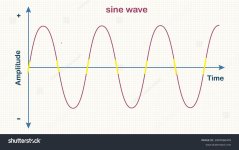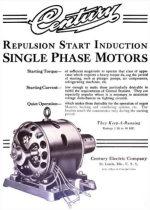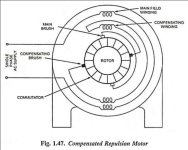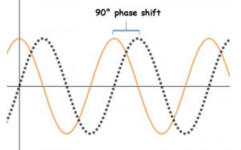You are using an out of date browser. It may not display this or other websites correctly.
You should upgrade or use an alternative browser.
You should upgrade or use an alternative browser.
Phase Shift 360 degrees?
- Thread starter kjroller
- Start date
kwired
Electron manager
- Location
- NE Nebraska
- Occupation
- EC
The phase shift is nothing more than current and voltage not reaching peak at the same time . All capacitors will have the same 90 degree differential between voltage and current. A higher value capacitor can however pass more current and current is a component in the power formula which is part of why the larger the motor the larger the capacitors typically are.
Now place the start or aux winding of a motor with it's current out of phase with the main winding and you can develop rotation in the magnetic fields in the motor. The more torque your motor needs for the application the more current may be needed to make stronger magnetic fields, but the phase differential of a capacitor is still 90 degrees.
Also keep in mind there is inductive reactance involved in the windings as well which is the opposite effect of capacitive reactance so the net phase shift between windings isn't solely dependent on the capacitor.
You might be able to cheat a little on giving a starting boost with a larger starting capacitor. This is exactly what HVAC hard start kits do. You should not cheat by increasing a run capacitor, it stays in the circuit the entire time the motor runs and will cause too much current for the winding to handle over that running time.
Now place the start or aux winding of a motor with it's current out of phase with the main winding and you can develop rotation in the magnetic fields in the motor. The more torque your motor needs for the application the more current may be needed to make stronger magnetic fields, but the phase differential of a capacitor is still 90 degrees.
Also keep in mind there is inductive reactance involved in the windings as well which is the opposite effect of capacitive reactance so the net phase shift between windings isn't solely dependent on the capacitor.
You might be able to cheat a little on giving a starting boost with a larger starting capacitor. This is exactly what HVAC hard start kits do. You should not cheat by increasing a run capacitor, it stays in the circuit the entire time the motor runs and will cause too much current for the winding to handle over that running time.
wwhitney
Senior Member
- Location
- Berkeley, CA
- Occupation
- Retired
The phase shift for an idealized capacitor will be 90 degrees. But once you consider the actual resistance of the capacitor (and possibly the circuit connecting to it, depending on where you are comparing voltage versus current), the phase shift will end up slightly less than 90 degrees. Whether or not the discrepancy is significant in the real world I don't know.I don't think there's even a 90° phase shift.
Cheers, Wayne
Joethemechanic
Senior Member
- Location
- Hazleton Pa
- Occupation
- Electro-Mechanical Technician. Industrial machinery
When the capacitor mis charging it's internal impedance is lower, when it is fully charged the impedance is close to infinity. So it is flowing more current on the upslope/downslope of the sign wave. Yellow highlighted areas.

BTW, starting capacitors are "bipolar" electrolytic capacitors. That is why they can have such a large microfarad value compared to a run cap of the same physical side.
Hopefully I remembered this right from electronics class in the 1970's lol. You might want to read about L-C circuits

BTW, starting capacitors are "bipolar" electrolytic capacitors. That is why they can have such a large microfarad value compared to a run cap of the same physical side.
Hopefully I remembered this right from electronics class in the 1970's lol. You might want to read about L-C circuits
Joethemechanic
Senior Member
- Location
- Hazleton Pa
- Occupation
- Electro-Mechanical Technician. Industrial machinery
Joethemechanic
Senior Member
- Location
- Hazleton Pa
- Occupation
- Electro-Mechanical Technician. Industrial machinery
Typo, I'm typing around a helpful catWhen the capacitor is charging it's internal impedance is lower
Yep - simple, innit !Basically you are creating two phase just like old Philadelphia ran/runs on
View attachment 2579190
And capacitor motors have a very similar armature (stator) winding arrangement to the old two phase motors
kwired
Electron manager
- Location
- NE Nebraska
- Occupation
- EC
I agree single phase motors are basically two phase motors with self contained component to create the phase differential.Basically you are creating two phase just like old Philadelphia ran/runs on
View attachment 2579190
And capacitor motors have a very similar armature (stator) winding arrangement to the old two phase motors
Capacitor motors are what people think of, but there is also motors in low power range with just two windings with different impedance and no capacitors. They don't develop a lot of starting torque, still have a centrifugal switch to cut out the aux winding once up to speed, then there is shaded pole motors, they too are essentially a two phase motor with main coil and the shading coil is going to have current that is out of phase with the main coil to produce rotating field.
Joethemechanic
Senior Member
- Location
- Hazleton Pa
- Occupation
- Electro-Mechanical Technician. Industrial machinery
I agree single phase motors are basically two phase motors with self contained component to create the phase differential.
Capacitor motors are what people think of, but there is also motors in low power range with just two windings with different impedance and no capacitors. They don't develop a lot of starting torque, still have a centrifugal switch to cut out the aux winding once up to speed, then there is shaded pole motors, they too are essentially a two phase motor with main coil and the shading coil is going to have current that is out of phase with the main coil to produce rotating field.
There were also these. Though I don't think I've seen one in 25 years. They were quite common on small machine tools and air compressors


kwired
Electron manager
- Location
- NE Nebraska
- Occupation
- EC
I don't think I have ever seen one but kind of recall hearing about them before.There were also these. Though I don't think I've seen one in 25 years. They were quite common on small machine tools and air compressors
View attachment 2579201
View attachment 2579202
Looking at how it is connected main field is only thing connected to the incoming supply, rotor and compensating winding only have current via induction from main winding.
Joethemechanic
Senior Member
- Location
- Hazleton Pa
- Occupation
- Electro-Mechanical Technician. Industrial machinery
I don't think I have ever seen one but kind of recall hearing about them before.
Looking at how it is connected main field is only thing connected to the incoming supply, rotor and compensating winding only have current via induction from main winding.
Joethemechanic
Senior Member
- Location
- Hazleton Pa
- Occupation
- Electro-Mechanical Technician. Industrial machinery
When I was a kid in the 60's I grew up around a lot of really old machine tools. My grandfather had a line shaft in his garage with leather belts running the machines. I remember seeing stuff something like this Emmerson but only there was a compensator with a starting handle on it that was a separate unit. Inside it had large coils, but I was in my single digit years, so I really didn't understand how it worked. I do remember him calling it a "Starting Compensator" and I liked to operate the handle to start the motor


